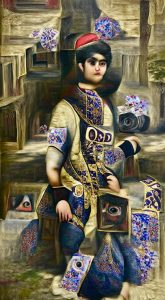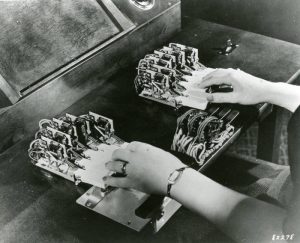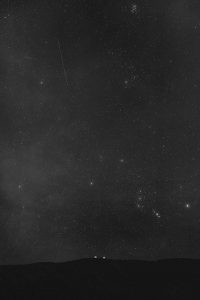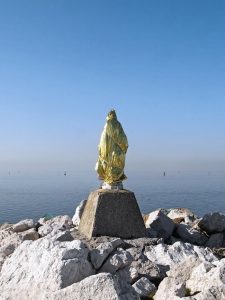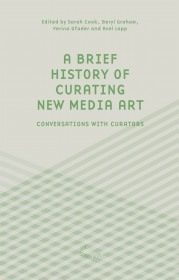 A Brief History of Curating New Media Art: Conversations with Curators, by Sarah Cook, Beryl Graham (available on amazon UK and USA.)
A Brief History of Curating New Media Art: Conversations with Curators, by Sarah Cook, Beryl Graham (available on amazon UK and USA.)
Its little companion, A Brief History of Working with New Media Art – Conversations with artists, is also out but because i’m one of the people interviewed i don’t dare to unwrap the book. Yes, that’s the way i am. Still, by the look of the volume i’m going to review and the names of the artists interviewed i suspect that the book is worth getting your hands on.
Publisher The Green Box says: This book of interviews tracks the work of curators in the field of new media art in order to consider the massive changes and developments over a relatively short period of time. They are also a celebration of the ten years that the online resource for curators of new media art, CRUMB, has been publishing interviews and other research. The curators featured in this book range across the contemporary arts. They have been working away, not in the centre or the periphery, but in the nodes of this networked field of new media art.
A Brief History of Curating New Media Art – Conversations with Curators was edited by Sarah Cook, Beryl Graham, verina Gfader and Axel Lapp. It contains interviews with Sarah Cook & Beryl Graham; Peter Weibel; Barbara London; Christiane Paul; Larry Rinder; Kathy Rae Huffman & Julie Lazar; Benjamin Weil; Liliane Schneiter, Yves Mettler & Anne-Julie Raccoursier; Liane Davison; Nathalie Anglès & Sebastien Sanz de Santamaria; Matthew Higgs; Magdalena Sawon & Tamas Banovich; Steve Dietz; Rudolf Frieling.
I read or just flipped through countless books that introduce and discuss new media art, A Brief History of Curating New Media Art is the first one i’ve found that explores the field from a purely curatorial perspective. The book is invaluable not only for new media art curators but also for other contemporary art curators, for artists, critics, and other professional of the field as it engages with issues that are relevant to their practice and extend beyond the strict art+tech discourse.
The book contains some of the interviews that the founders of the CRUMB mailing list have been conducting over the past 10 years. From the look of the current situation (which we could define as an under-representation of new media art in most museums and mainstream cultural institutions), many of the problems that rose 10 years ago at the peak of the hype of new media art are still in dire need to be resolved. And 10 years is a hell of a long time in this relatively young field.
Sarah Cook has a telling anecdote about her curatorial practice:
When Steve Dietz and I were curating The Art Formerly Known as New Media at the Banff Center, we put all our installation photos up on Flickr and almost got told off out of concern that it would be infringing contractual agreements with the artists about official photography and dissemination of images of their work. So on the one hand it’s [reflecting on my curatorial practice] made me more open, and on the other it’s made me really ask, “Why do i continue to curate new media in these older institutions which are really traditional in their methods?”
Each of the 14 interview starts with a very brief bio of the interviewee and a list of keywords that sum up the main aspects highlighted during the conversation. I wish the book contained a higher number of interviews with non-American or non US-based curators. Hopefully this might come in “A Brief History of Curating New Media Art Part 2”?
The interviews obviously spotlight the profession of media art curator: How much should a media art curator know about technology? How much role should they take in the art production process? How do you deal with the restraints imposed by technology and sponsors in creating a show? And more generally, how does working with media art affects the practice of a curator?
However, the interviews engage also with the bigger picture: How specific is Media art within the contemporary landscape? How can it be integrated into knowledge and education? How do you keep the focus on art amidst the gloss and glitter of technology? What is its audience? How can it be developed locally? How do you document the show?
The conversations also cover the more techy details that pave the way to new media art: Whether we talk of a net.art work or an interactive installation what are the costs of its maintenance? What is the role of open source and what is its potential as part of the art practice?
Image on the homepage RYBN, antidatamining, 2006-2010 at Laboral, Gijón.
Related: Interview with Sarah Cook.

